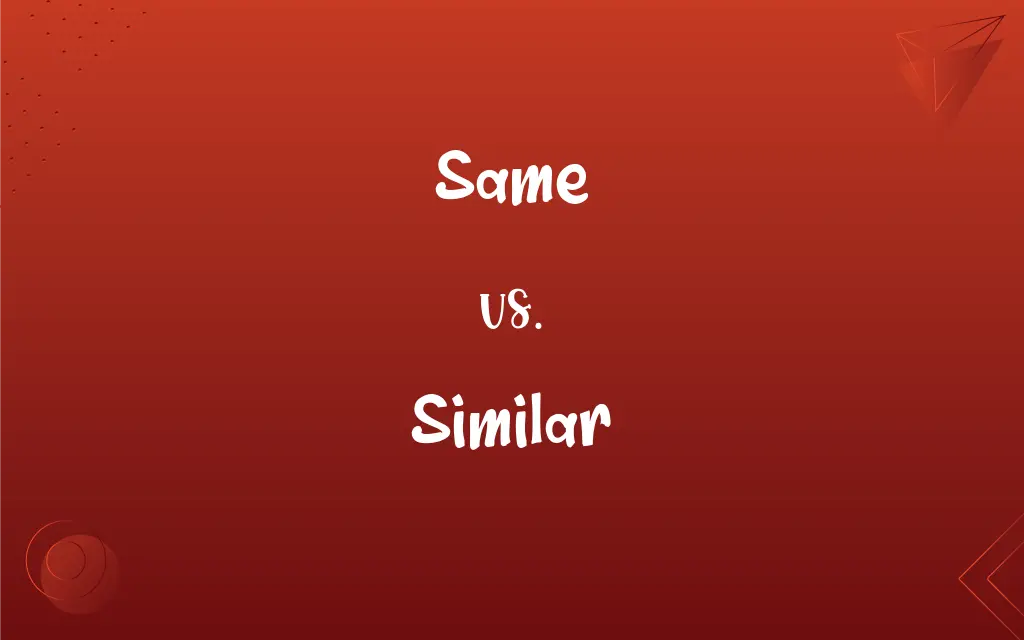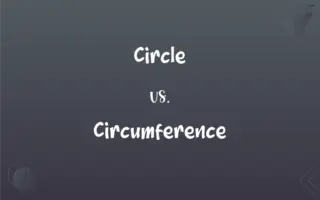Same vs. Similar: What's the Difference?
Edited by Aimie Carlson || By Janet White || Updated on September 28, 2023
“Same” denotes identicalness in all aspects, while “Similar” implies likeness or resemblance, without being identical.

Key Differences
“Same” and “Similar” are terms often used interchangeably but with different nuances. “Same” implies an exact match or identicalness in every aspect, attribute, or characteristic, with no variation or difference noted. This denotes that the objects, ideas, or individuals being compared share all properties, values, and attributes. In contrast, “Similar” conveys that there is a likeness or resemblance, with some degree of commonality in features, properties, or attributes, but not in all aspects.
In practical and everyday scenarios, using “Same” would mean that two or more objects or entities are indistinguishable from one another in every attribute, like two identical twins. The word “Similar”, however, allows for differences, stating that while there are common elements, there are also distinctions, like two siblings having a familial resemblance but different features and attributes.
In mathematical and logical contexts, “Same” represents absolute equivalence, where two values, shapes, or expressions are indistinguishable and interchangeable. On the other hand, “Similar” in mathematical terms could refer to shapes having the same angles and proportional sides but different sizes, signifying likeness but not absolute identity in all properties.
The nuanced difference between “Same” and “Similar” is crucial in scientific research, legal contexts, and analytical discussions, where precision and accuracy in description and categorization are pivotal. “Same” denotes an unequivocal match, allowing no room for disparity, while “Similar” provides a comparative perspective, acknowledging resemblance but also accommodating variations and discrepancies.
In linguistic terms, while “Same” indicates a complete match in meaning, context, or pronunciation, “Similar” suggests a likeness in sound, meaning, or usage, acknowledging the possibility of variations. It is crucial to choose the appropriate term to convey the desired level of comparison and resemblance accurately.
ADVERTISEMENT
Comparison Chart
Definition
Identical in all aspects.
Having a likeness or resemblance.
Level of Comparison
Denotes absolute equivalence.
Implies a degree of commonality.
Flexibility
Inflexible, allows no variation.
Flexible, accommodates variations.
Contextual Usage
Used for identical objects or concepts.
Used for likenesses with permissible differences.
Application
Applies to indistinguishable entities.
Applies to entities with common characteristics.
ADVERTISEMENT
Same and Similar Definitions
Same
Unchanged in condition, quantity, or effect.
The price is the same as it was yesterday.
Similar
Comparable in appearance or nature; alike but different.
The twins are similar, yet they have distinct personalities.
Same
Equally matched or comparable in degree.
She treats all her students the same.
Similar
Equivalent or analogous in function or effect.
The children grew up in similar socio-economic conditions.
Same
Identical in characteristics, nature, or form.
We bought the same model of the car.
Similar
Exhibiting likeness or resemblance.
The two paintings are quite similar.
Same
Being the very one; identical
The same boat we rented before.
Similar
Resembling someone or something without being identical.
Their products are similar but not the same.
Same
Similar in kind, quality, quantity, or degree
The ceremony went off with the same elegance that it has had every year.
Similar
Having characteristics in common; alike in substance or essentials.
They have similar tastes in music.
Same
Conforming in every detail
According to the same rules as before.
Similar
Having a resemblance in appearance or nature; alike though not identical.
Same
Being the one previously mentioned or indicated; aforesaid
"There was a man in Jerusalem, whose name was Simeon.
And the same man was just and devout" (King James Bible).
Similar
(Mathematics) Having corresponding angles equal and corresponding line segments proportional. Used of geometric figures
Similar triangles.
Same
In the same way
The words sale and sail are pronounced the same.
Similar
Having traits or characteristics in common; alike, comparable.
My new car is similar to my old one, except it has a bit more space in the back.
Same
Not different or other; not another or others; not different as regards self; selfsame; identical.
I realised I was the same age as my grandfather had been when he joined the air force.
Even if the twins are identical, they are still not the same person, unlike Mark Twain and Samuel Clemens.
Peter and Anna went to the same high school: the high school to which Peter went is the high school to which Anna went.
Similar
(mathematics) Of geometrical figures including triangles, squares, ellipses, arcs and more complex figures, having the same shape but possibly different size, rotational orientation, and position; in particular, having corresponding angles equal and corresponding line segments proportional; such that one can be had from the other using a sequence of rotations, translations and scalings.
Same
Lacking variety from; indistinguishable.
Similar
Of two square matrices; being such that a conjugation sends one matrix to the other.
Same
Similar, alike.
You have the same hair I do!
Similar
That which is similar to, or resembles, something else, as in quality, form, etc.
Same
Used to express the unity of an object or person which has various different descriptions or qualities.
Round here it can be cloudy and sunny even in the same day.
We were all going in the same direction.
Similar
(homeopathy) A material that produces an effect that resembles the symptoms of a particular disease.
Same
A reply of confirmation of identity.
Similar
Exactly corresponding; resembling in all respects; precisely like.
Same
(used with the) The same way; in the same manner; to the same extent, equally.
A mother loves all her children the same.
My hometown looked much the same as when I'd left 10 years ago.
It took all night to find our hotel room, as we forgot our room number and each door looked the same.
Similar
Nearly corresponding; resembling in many respects; somewhat like; having a general likeness.
Same
Together.
Similar
Homogenous; uniform.
Same
The identical thing, ditto.
The same can be said of him.
It's the same everywhere.
Similar
That which is similar to, or resembles, something else, as in quality, form, etc.
Same
Something similar, something of the identical type.
She's having apple pie? I'll have the same.
You two are just the same.
Similar
Marked by correspondence or resemblance;
Similar food at similar prices
Problems similar to mine
They wore similar coats
Same
It or them, without a connotation of similarity.
The question is his credibility or lack of same.
Similar
Having the same or similar characteristics;
All politicians are alike
They looked utterly alike
Friends are generaly alike in background and taste
Same
It or them, as above, meaning the last object mentioned, mainly as complement: on the same, for the same.
My picture/photography blog...kindly give me your reviews on the same.
Similar
Resembling or similar; having the same or some of the same characteristics; often used in combination;
Suits of like design
A limited circle of like minds
Members of the cat family have like dispositions
As like as two peas in a pod
Doglike devotion
A dreamlike quality
Same
(Internet slang) Indicates the speaker's strong approval or agreement with the previous material.
Similar
(of words) expressing closely related meanings
Same
Not different or other; not another or others; identical; unchanged.
Thou art the same, and thy years shall have no end.
Similar
Capable of replacing or changing places with something else;
Interchangeable parts
Same
Of like kind, species, sort, dimensions, or the like; not differing in character or in the quality or qualities compared; corresponding; not discordant; similar; like.
The ethereal vigor is in all the same.
Same
Just mentioned, or just about to be mentioned.
What ye know, the same do I know.
Do but think how well the same he spends,Who spends his blood his country to relieve.
Bees like the same odors as we do.
[He] held the same political opinions with his illustrious friend.
Same
Same in identity;
The same man I saw yesterday
Never wore the same dress twice
This road is the same one we were on yesterday
On the same side of the street
Same
Closely similar or comparable in kind or quality or quantity or degree;
Curtains the same color as the walls
Two girls of the same age
Mother and son have the same blue eyes
Animals of the same species
The same rules as before
Two boxes having the same dimensions
The same day next year
Same
Equal in amount or value;
Like amounts
Equivalent amounts
The same amount
Gave one six blows and the other a like number
An equal number
The same number
Same
Unchanged in character or nature;
The village stayed the same
His attitude is the same as ever
Same
In the same manner;
You get treated fairly, same as any other student in this course!
Same
Referring to the identical individual or thing mentioned earlier.
He broke the glass and cut his hand with the same.
Same
Used to emphasize that something is unaltered or unchanged.
Even after the discussion, his opinion remained the same.
FAQs
Is “Same” more restrictive than “Similar”?
Yes, “same” is more restrictive, implying absolute identicalness.
Are “Same” and “Similar” used interchangeably?
They are sometimes used interchangeably but have nuanced differences.
Can “Same” refer to the exact individual or thing?
Yes, “same” can refer to the exact individual or thing mentioned earlier.
Can “Same” accommodate any differences?
No, “same” suggests complete identicalness with no differences.
Does “Similar” allow for variations?
Yes, “similar” implies likeness but allows for differences and variations.
Can “Similar” be used in a comparative sense?
Yes, “similar” is often used to compare entities based on likeness.
Does “Similar” imply identicalness in all attributes?
No, “similar” denotes resemblance but not identicalness in all attributes.
Do “Same” and “Similar” have different meanings?
Yes, “same” implies identicalness, while “similar” denotes resemblance with possible variations.
Is “Same” absolute in comparison?
Yes, “same” is absolute and denotes complete equivalence.
Is the word “Same” used to express unchangeability?
Yes, “same” can be used to emphasize unaltered conditions or quantities.
Can two things be similar in some aspects but not the same?
Yes, things can be similar in some aspects while having differences, hence not being the same.
Is it incorrect to use “Same” for things that are merely similar?
Using “same” for things that are merely similar may lead to inaccuracies in communication.
Can “Similar” express a degree of comparison?
Yes, “similar” can express a degree of comparison based on likeness or resemblance.
Can “Similar” denote common characteristics between entities?
Yes, “similar” is often used to denote common characteristics between entities.
Are “Same” and “Similar” relative terms?
“Same” is absolute, while “similar” is relative and dependent on context.
About Author
Written by
Janet WhiteJanet White has been an esteemed writer and blogger for Difference Wiki. Holding a Master's degree in Science and Medical Journalism from the prestigious Boston University, she has consistently demonstrated her expertise and passion for her field. When she's not immersed in her work, Janet relishes her time exercising, delving into a good book, and cherishing moments with friends and family.
Edited by
Aimie CarlsonAimie Carlson, holding a master's degree in English literature, is a fervent English language enthusiast. She lends her writing talents to Difference Wiki, a prominent website that specializes in comparisons, offering readers insightful analyses that both captivate and inform.
































































